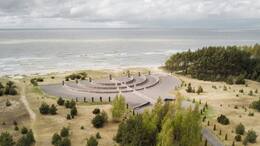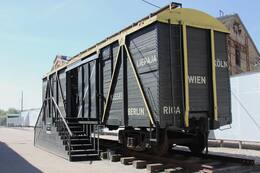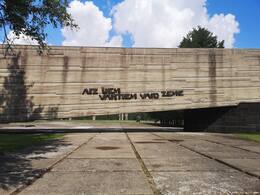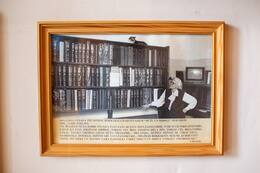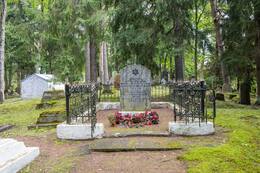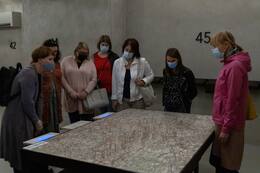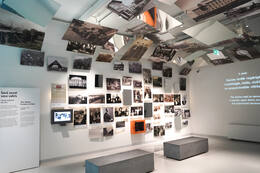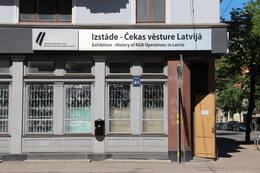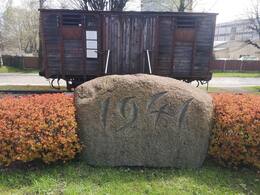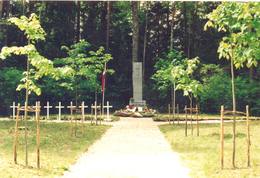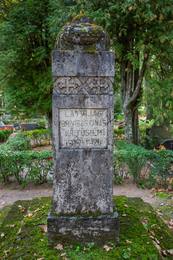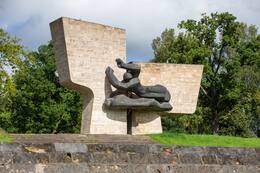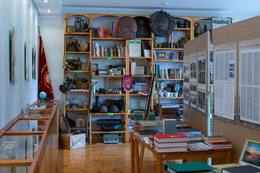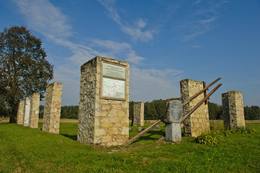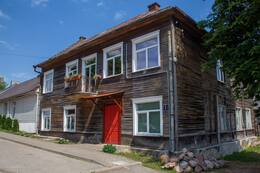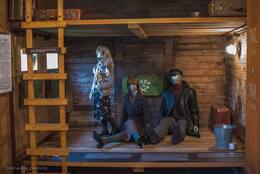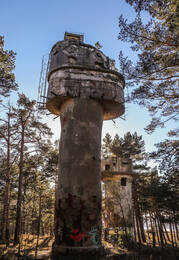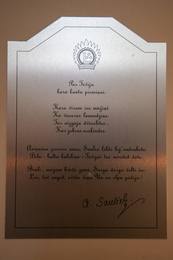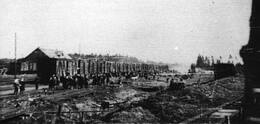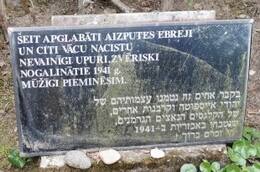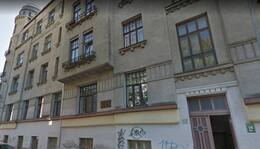Genocido II WW2, IV Sovietų okupacija
Genocidas (iš senovės graikų kalbos žodžio „genos“ – rasė ar gentis, o lotyniškai „cide“ – žudymas) yra veiksmas, kuriuo siekiama visiškai ar iš dalies sunaikinti tautinę, etninę, rasinę ar religinę grupę kaip tokią: žudant šios grupės narius, juos fiziškai suluošinant ar psichiškai traumuojant, sąmoningai sukuriant tokiai grupei gyvenimo sąlygas, tyčia apriboti jos gimstamumą arba iš dalies apskaičiuojant tyčia Vienos grupės vaikų perkėlimas gyventi į kitą grupę. Genocidas apima ir fizinį aspektą – konkrečių veiksmų, tokių kaip konkrečios žmonių grupės narių žudymas, sąrašą, ir psichologinį aspektą: šie veiksmai atliekami turint konkretų tikslą visiškai arba iš dalies sunaikinti tautinę, etninę, rasinę ar religinę grupę „kaip tokią“.
Be to, 1948 metų konvencija numato, kad, be faktinio genocido vykdymo, baudžiamas ir baudžiamas sąmokslas (slaptas ar atviras susitarimas), kuriuo siekiama organizuoti genocidą, atviras ir viešas kurstymas vykdyti genocidą, pasikėsinimas vykdyti genocidą, dalyvavimas genocide.
Masinis latvių naikinimas Sovietų Sąjungoje 1937-1938 m. Taip pat žinomas kaip genocidas arba etnocidas, tai buvo platesnio politiškai motyvuoto etnocido prieš kelias tautines mažumas, gyvenusias SSRS Didžiojo teroro metu, dalis. SSRS vidaus reikalų liaudies komisariato (NKVD) įsakymu, „siekiant likviduoti Latvijos žvalgybos darbą ir sunaikinti latvių nacionalistinę, antisovietinę veiklą SSRS teritorijoje“, buvo suimta daugiau nei 22 tūkst. latvių, žinoma, kad 16 573 iš jų buvo sušaudyti ir slapta palaidoti Kurka, Buttupavo, masinėse Komvovaresto ir kitose vietose. Kaime buvo likviduotos 372 latvių kolonijos ir kolūkiai, tarp kurių buvo apie 12 000 latvių ūkių. Tikslus aukų skaičius nežinomas, nes šis nusikaltimas nebuvo teisiškai ištirtas, o kaltininkai nepatraukti atsakomybėn.
1998 m. birželio 17 d. Latvijos Respublikos Saeima nusprendė totalitarinio komunistinio režimo genocido prieš Latvijos tautą aukų atminimo dieną paminėti kiekvienų metų pirmąjį gruodžio sekmadienį. Latvijoje taip pat minimos dvi komunistinio genocido aukų atminimo dienos kovo 25 ir birželio 14 d., skirtos 1949 m. kovo ir 1941 m. birželio trėmimų aukų atminimui. Tuo tarpu liepos 4-ąją minima Žydų genocido aukų atminimo diena.
Daugiau informacijos šaltinių
Genocido. Vikipedija. https://lv.wikipedia.org/wiki/Genocide
Totalitarinių okupacinių režimų represijos prieš Latvijos gyventojus. 1940-1953 m. Latvijos nacionalinis istorijos muziejus: http://lnvm.lv/?page_id=3976
Totalitariniai okupaciniai režimai Latvijoje 1940-1964 m. Latvijos istorikų komisijos tyrimas. Latvijos istorikų komisijos straipsniai. 13 tomas. Ryga, 2004. https://www.president.lv/storage/kcfinder/files/item_1618_Vesturnieku_komisijas_raksti_13_sejums.pdf
Susijusi laiko juosta
Susijusios vietos
Memorial to victims of communist genocide
This memorial is situated in Pilistvere cemetery.
Groundwork for the memorial began in 1988, with 300 people rallying to the cause. The joint effort of volunteers continues to this day, with improvements being made to the memorial each year. The idea for the memorial came from freedom fighter Lagle Parek.
At its centre lies a cairn of rocks brought from places over Estonia, from Siberia and from even further afield by Estonian expats. The cairn is crowned by a large cross. The foot of the cross is a symbolic tomb, to which Estonian people bring rocks to commemorate loved ones deported to Siberia.
The cairn is surrounded by boulders, one for each county, designed by Aate-Heli Õun and set in place in phases.
Near the memorial are memorial stones to the victims of the radiation from Chernobyl, to the Forest Brothers, to those conscripted into the NKVD’s labour columns, to Estonian volunteers in the Finnish army and to freedom fighters. These were all designed by Endel Palmiste.
In addition to the cairn, a grove of more than 2000 memorial trees has been planted near the memorial. The grove was designed by renowned landscape architect Andres Levald.
The historic Pilistvere pastorate, serving as the main building at the memorial site, houses an archive and an Estonian History Museum exhibition about the occupation of Estonia.
Memorial to the victims of holocaust in Liepāja
The largest memorial to Holocaust victims in Latvia is located in Liepāja, in the Šķēde dunes. The memorial is dedicated to the memory of more than 3,000 Liepāja Jews killed during World War II. It is in the form of the Israeli national symbol, a seven-branched candelabra known as the menorah. The contours of the memorial, which are clearly visible from a bird’s eye view, are made of split boulders and granite blocks. The ‘lights’ of the menorah are made of granite pillars with inscriptions of verses from the Lamentations of Jeremiah in Hebrew, English, Latvian and Russian.
Riga Ghetto and Latvian Holocaust Museum
The Riga Ghetto and the Latvian Holocaust Museum is located in Riga close to the Riga Central Market and the Riga Central Station. The museum was opened in 2010 on the site where the city's warehouses once were. It is located in the historical part of the city, next to the border of the former Jewish ghetto. The territory of the ghetto is unique, because in terms of architecture it has not changed since World War II. It is a memorial dedicated to the tragedy suffered by the Jewish people. The German policy regarding the Jewish population in Latvia until the end of 1939 was for the German diplomats and politicians to try and pressure the Latvian government to take action against the Jews by restricting their freedom. After the emigration of the Baltic Germans in 1939, the German embassy no longer had as good an access to information on the mood of the population and the events happening in Latvia as before. When the Red Army occupied Latvia, they manipulated the society to gain some support of the Jewish population for the new occupying power. However, after the regime started a crackdown on the society as a whole, the support fell rapidly. As a result of all this, a deep divide had formed between the people. And later on, the next regime – Germany – tried to exploit it. They hoped that the local population would harass and attack the Jews, but that did not happen. So, Germany adjusted their approach and devised a new plan to initially establish a Jewish ghetto and later destroy its inhabitants.
Salaspils Memorial Ensemble
Salaspils Memorial and historical exhibit is located in Salaspils municipality, 1.2 km from the Riga-Daugavpils A6 highway. The Salaspils Memorial was unveiled in 1967 on the site where during World War II the Salaspils Camp was once located. It is a place that was used for Soviet propaganda and is shrouded in myths and half-truths. It is a good representation of the Nazi crimes and Communist ideology that was carried out during each of the occupations. This repressive camp was a part of the German penitentiary system. It had similarities with concentration camps, but it was not the same thing. It was created so that there would not be a disproportionate number of prisoners in Riga prisons. This camp was an “extension of the police prison”. And a variety of people were imprisoned here – Jews, the Red Army prisoners of war, absentees, political prisoners, criminals, prostitutes, members of the Latvian resistance movement, Baltic soldiers in the German Army or police, and others. The camp could hold up to 2,200 prisoners. The main cause of death (~2000) was malnutrition, working conditions, corporal punishment and illness.
Museum of Melānija Vanaga and Siberian dugout
The Melānija Vanaga Museum is located in the Amata village school in Cēsis municipality. The museum showcases materials about the life, literary activity, family and destiny of writer and cultural historian Melānija Vanaga: video content about Siberia and the deported Latvians living there and a Siberian dugout taking its visitors on a trip to the writer’s place of deportation in Tyukhtetsky district, Krasnoyarsk region. The appearance and layout of the dugout form a realistic idea of life away from home. The dugout features unique historical objects brought there from the Tyukhtet Museum: a birch-bark dish known as ‘tuyesok’, a clay mug known as ‘krynka’ and a kerosene lamp. The museum features video interviews with politically repressed people from the municipality and 18 characters from Melānija Vanaga’s book Suddenly, a Criminal: Sixteen Years in Siberia. The museum’s virtual exhibition ‘BE YOURSELF!’ (http://esipats.lv) shows the experiences of five deported children and their parents who were wrongly accused by the Soviet authorities of ‘betrayal of the motherland’.
Varaklani Jewish Cemetery - a memorial to the victims of German-fascist terror
Varakļāni Jewish Cemetery, at the end of Kapsētas Street.
There are two monuments erected in the Varakļāni Jewish cemetery after the war by surviving relatives and relatives.
One of them is located near the cemetery fence, where the mass extermination of Jews took place. The inscription on it in Russian and Yiddish reads: "We will mourn forever with our parents, brothers and sisters who died at the hands of the fascists in 1941." The second monument is inside the cemetery; In the place where the killed Jews were later reburied, there is also an inscription in Yiddish and Russian: "Eternal memory of the victims of the German-fascist terror - the Jews of Varakļāni, brutally killed on August 4, 1941".
Nazi German troops entered Varaklani in 1941. In early July, and from the very first days, the siege and isolated killings of Jews began. A conditional ghetto was established near the Jewish cemetery, to which all Jews had to move. On August 4, a German SD unit (the "Arāja team") shot virtually all Jews in Varakļāni (about 540 people) with the help of local self-defense forces on the territory of the Jewish cemetery.
Every year on the first Sunday of August, a memorial event dedicated to the Jews killed in Varakļāni takes place in the Varakļāni Jewish Cemetery.
Memorial Wall of Pain
Artrodas Litene cemetery.
On June 14, 2001, the memorial “Wall of Pain” created by architects Dina Grūbe, Benita and Dainis Bērziņš, stonemasons Ivars Feldbergs and Sandra Skribnovskis was unveiled in Litene Cemetery, it symbolizes the resting place of the soldiers killed in 1941. In October 1988, the ashes of 11 officers killed in June 1941 by the Soviet Army were found in the territory of the former Latvian Army summer camp in Sita Silila, Litene Parish. Although they could not be identified, on December 2, 1989, at the consecration service in Gulbene Evangelical Lutheran Church, Litene Cemetery was solemnly reburied.
11 white crosses, memorial plaque and information stands.
Historical Exposition “The Burning Conscience”
The historical exhibit ‘Fire of Conscience’ is located in Cēsis, near the Cēsis Castle Square. Established in a Soviet-era temporary detention facility, it tells about the occupation of Latvia and reveals surprising and heroic stories of resistance from individuals. The yard features a memorial wall with the names of 643 residents of the former Cēsis district who died in Soviet repressions, including national partisans deported in 1941 and 1949 and those shot and sentenced to death. The exhibit’s timeline encourages visitors to study the course of the occupation of Latvia from 1939 to 1957. Arranged by topics, quotes from local newspapers offer a comparison of the political propaganda of the two occupation regimes. The six cells for temporary detention have survived to the present day in their original form from 1940 to 1941 and the post-war years. Here, the residents of Cēsis district, detained for various anti-Soviet activities, including national partisans, their supporters, young people who distributed anti-Soviet leaflets and other ‘traitors of the motherland’, were held for several days during the initial investigation and interrogation before being sent to the main KGB Building in Riga. Everything here is real: cells with iron doors, built-in ‘kormushkas’ (small openings for providing food), plank beds, a latrine for detainees, a small kitchen with an oven, as well as typical Soviet-era oil paint on the walls. In 2019, the exhibit was ranked third in the national design competition, the Latvian Design of the Year Award.
Museum of the Occupation of Latvia
The museum exhibits the history of Latvia from 1940 to 1991, under the occupation of Nazi Germany and the Soviet Union. ‘House of the Future’ is a reconstruction and expansion project of the Occupation Museum designed by the well-known American Latvian architect Gunārs Birkerts as well as the new exhibit of the museum. The exhibit ‘History of Cheka in Latvia’ was created by the Occupation Museum and it is located in the ‘Corner House’, which is the former USSR State Security Committee (KGB) building. Latvian Occupation Museum was founded in 1993. It tells the long-hidden story of the fate of the Latvian state, nation and land under the occupation of two foreign totalitarian powers from 1940 to 1991. At the end of 2020 the museum had more than 70,000 different historical items (documents, photographs, written, oral and material evidence, objects and memorabilia). Museum specialists have recorded more than 2,400 video testimonials, making it one of the largest collections on occupation in Europe. The events that unfolded in Latvia, Lithuania and Estonia clearly show us what the nations had to endure under the two totalitarian regimes.
Exhibition in the KGB Building "History of KGB Operations in Latvia"
The former USSR State Security Committee (commonly known as Cheka) building is open for visitors. Here chekists imprisoned, interrogated and murdered Latvian citizens who were considered opponents by the occupation regime. There is also an exhibit from the Latvian Occupation Museum on the activities of Cheka in Latvia. Guided tours of the prison cells, corridors, basement and courtyard are available. The house was built in 1911 and it is one of the most beautiful buildings in Riga. Called the ‘Corner House’ by the people, it was the scariest symbol of the Soviet occupation regime in Latvia, and also one of the pillars of power of the USSR. Cheka operated from the Corner House during the occupation from 1940 to 1941 and then again from 1945 to 1991. Tens of thousands of Latvians were affected by direct political persecution. The fight against enemies of Soviet rule continued also after World War II. Cheka’s approach towards its operation slightly changed after Stalin’s death. Physical torture was replaced by psychological terror. The majority of Cheka agents were Latvians (52%). Russians were the second largest group – 23.7%. 60.3% of the agents were not members of the Communist Party. 26.9% of the agents had higher education. The system was designed in a way to involve local people and thus have greater control over the society. Staff documents and service records are located in Russia. And these materials have not been made available to Latvian authorities and researchers.
Victims of Communist Terror Memorial in Torņakalns
The memorial site is located in the Torņakalns railway station in Riga. It is dedicated to those deported in June 1941. Initially it was planned to create a memorial in Esplanāde park, but later it was decided to place it at the Torņakalns station. The memorial consists of five torn stone sculptures symbolising the ruined families and three generations of deportees. The sculptor of this memorial is Pauls Jaunzems and the architect is Juris Poga. It was unveiled on 14 June 2001 by the then President of Latvia, Vaira Vīķe-Freiberga. Next to the station there is a freight waggon and a commemorative stone dedicated to the deported Latvians. The commemorative stone with the inscription “1941” is a 1.2 m high crude boulder. The author of the memorial stand is the sculptor Ojārs Feldbergs.
Alūksne Garrison Cemetery
Located on the shores of Lake Alūksne, on the Kapsēta peninsula, in the territory of the Great Cemetery.
They were started and maintained by the soldiers of the 7th Sigulda Infantry Regiment in the 1930s and consecrated on November 11, 1932. After the restoration of Latvia's independence, Uldis Veldre, the head of the department of the Alūksne Brothers' Cemetery Committee, took care of the maintenance of the Garrison Cemetery, the identification of the resting places associated with Alūksne and the installation of memorials in the Garrison Cemetery.
Military personnel of the Army of the Republic of Latvia were buried in the garrison cemetery, as well as soldiers and civilians killed in the fight against the Bolsheviks on July 4, 1941 in Alūksne near Jāņkalniņš and on July 7, 1941 in Ziemera parish.
Most of the buried have white wooden crosses with metal plaques, which indicate the name of the deceased, the rank or occupation, as well as the date of birth and death.
On December 19, 1990, a memorial to Vilius Spandeg, a knight of the Lāčplēsis Military Order, was unveiled in the Garrison Cemetery. Standard memorial plaques were also erected to the LKOK, who died or were killed in communist concentration camps and were not buried in Latvia. On November 11, 1990, a memorial was erected to Voldemārs Zaķis, who died in the communist concentration camp.
Karvas Brothers Cemetery
It is located on the side of Alūksne - Ape road near the Eel House, south of Karva, turning to Rezaka.
The monument was unveiled on September 12, 1937. The granite stencil was designed by Oem Dambekalns in Riga in Riga by the architect Vemera Vitand.
In the autumn of 1975, the local communists destroyed the monument. On March 30, 1989, the Alūksne District Council decided to restore the monument, and on April 30, 1989, a temporary wooden memorial in the form of a Latvian tombstone was erected by Jānis Jaunzems, a worker at the State Electrotechnical Factory (VEF). It read: "The monument to the Karvas Brethren will be restored here."
At that time, the adjacent Brothers' Cemetery was also improved.
In 1993, thanks to the initiative of Uldis Veldre, the head of the Alūksne Brothers' Cemetery Committee, the restoration of the memorial site resumed. The new monument was made by Cēsis stonemason brothers Aivars, Austris and Auseklis Kerliņi.
The monument was unveiled on June 11, 1994.
Four soldiers of the 5th Company of the Valmiera Infantry Regiment are buried in the Brothers' Cemetery - Jēkabs Sukse, Pēteris Leitlands, Ernests Puķītis and Gustavs Ozols, who died on April 2, 1919 in the battles at the Eel House. Roberts Grazer, a soldier of the Valmiera Regiment, was buried as the fifth soldier of the Valmiera Regiment in the mid-1930s, and disappeared on March 31, 1919 at the New Manor. Initially, he was buried as an unknown, but later the name was found and carved into the monument. Augusts Dzedons (Ziedons), the fifth soldier who died in the Battle of Eel, was buried in the Apekalns cemetery.
A memorial plaque has been erected at the foot of the monument to Jānis Goldem (1891–1952), a participant in the eel battle in LKOK, who died in the Communist concentration camp in Inta, Komi.
The second memorial plaque, unveiled on August 23, 1992, was erected at one of the wooden crosses and is dedicated to Corporal Peter Janson of the 7th Sigulda Infantry Regiment, who was assassinated by the oncoming communists on July 7, 1941.
Military heritage monuments in Dīvaliņš cemetery in Valmiera
Located in Valmiera Dīvala (Jāņa) cemetery in Valmiera.
A monument made in the Allaži limestone by sculptor Marta Lange was unveiled on September 26, 1937.
The pillared monument is closed by an inclined altar, on which there is an oak wreath and a helmet made of limestone.
Approximately 80 soldiers who died in the Latvian War of Independence, as well as those who died from injuries and illnesses, are buried.
Nearby is one of the lesser-known works of Kārlis Zāle - a monument “Broken Roses”, which is connected with the establishment of the Brothers' Cemetery Ensemble.
There is also a memorial to the victims of communist terror - a stone with the inscription: "The assassins of the 1941 communist regime" and white crosses.
Memorial to the soldiers fallen in World War II
The memorial ensemble in Valmiera was unveiled in 1985. World War II Soviet soldiers who fell in the vicinity of Valmiera and victims of Nazi terror have been reburied in the Brothers’ Cemetery. The authors of the memorial ensemble are sculptors Zigrīda Rapa and Juris Rapa, architects Ēvalds Fogelis, Jānis Lejnieks, Jānis Rutkis and Andris Vītols, and Design Engineer Ivars Veldrums. Limestone from the village of Allaži was used to decorate the memorial ensemble. Its main image is the split linden tree of the Coat of Arms of Valmiera city. Two sculptures on each side of the ensemble symbolise the rhythm of life and death. The figures facing the Gauja river form a semi-circular space, marking the boundary between the past and the present. The main image facing the city is part of an intense arch-shaped form. The figure of a soldier faces the visitors approaching from the side of the city by the bridge, with the diagonal shape formed by the soldier’s hand supporting his deceased companion. On the burial terrace, soldiers have been laid down in rows for those who fought shoulder to shoulder in battle to lie under the same turf. A composition named the Golden Apple Tree lies separately on the lower terrace of the memorial. A granite plaque commemorates the Jews reburied here. Some of the elements, including bronze apples with the ensemble’s message encrypted by the authors, which had been placed under the growing apple tree, disappeared in the 1990s. A QR code next to the memorial gives visitors access to an audio guide with the information available in Latvian, Russian, English, Estonian and German.
Permanent exposition of local history of Vaidava parish
Located in Vaidava Culture and Craft Center.
There is an exposition dedicated to the memory of the deportations of 1949, as well as the participation of the people of Riga in the January 1991 barricades in Riga. Evidence of world wars (mainly printed materials) can also be seen in the exhibition.
Natural and historical objects, manors, history of education, culture, notable people, materials of the collective farm time, household items, banknotes, newspapers, magazines about Vaidava parish.
Memorial to the Victims of Communist Terror for the Repressed in Jaunrauna Parish
Located in "Baižēni", Priekuli parish
A memorial place for the repressed was created in the place of the ruins of the barn of the "Baižēni" house, where on the night of March 25, 1949, 40 residents of Jaunrauna parish were kept to take their way to Lode railway station and Siberia in the morning.
The repressed included children under 1 year of age and 87-year-olds.
The names of those who were shot or died in exile are also written on the memorial plaque. Next to it are memorial stones to the Knights of the Lāčplēsis War Order.
Privati ekspozicija „Abrenės kambariai“ (Abrenes istabas)
Privati ekspozicija „Abrenės kambariai“ įsikūrusi Viliakos mieste, istoriniame pastate. Iš pradžių šis pastatas stovėjo senosios Marienhauzeno turgaus aikštėje. Vėliau čia vei kė butai, biurai, įvairios parduotuvės, o Antrojo pasaulinio karo metais – latvių savigynos štabas, gestapas ir čekistų būstinė. Ekspozicijose pristatomi įvairūs Viliakos ir jos apylinkių isto rijos laikotarpiai bei įvykiai nuo 1920 iki 1960 metų – kai miestelis priklausė Jaunlatgalės, vėliau Abrenės apskri čiai. Tarp eksponatų – Stompakų pelkės partizanų štabo daiktai, pasakojantys apie nacionalinį pasipriešinimą Lat galoje, taip pat dokumentai ir fotografijos iš Nepriklauso mybės kovų laikotarpio. Naujausioje ekspozicijoje lankytojai gali susipažinti su ka daise garsia motokroso trasa „Baltasis briedis“.
Cattle wagon used for deportations – museum at Skrunda train station
To commemorate the deportations of June 1941 and March 1949, a memorial stone and a four-axle wagon, which also serves as the museum dedicated to deportations, was erected at the Skrunda railway station. This is the first wagon-type museum in Latvia that holds a permanent exhibit of photos, letters, memoirs, documents and various items made by the people deported from the Skrunda station. Skrunda station was a location where deportees were gathered, and one of the three stations in the region to which people from the Skrunda and the Kuldīga area were brought. In 1941, the family of the first President of the restored Republic of Latvia, Guntis Ulmanis, was deported from here to Krasnoyarsk Krai in Siberia.
With the help of deportations, the Soviets dealt with supporters of the national partizans’ and at the same time intimidated the remaining rural population, forcing them to join the collective farms.
Karosta, the Military port of Liepāja (tour)
The Karosta is the largest historical military territory in the Baltics and occupies almost one third of the entire territory of Liepāja. The Karosta is a unique compound of military and fortification buildings on the shores of the Baltic Sea with a special meaning in the history and architecture of Latvia and the world. The Karosta features such military heritage sites as the North Pier and forts, the Redan, Karosta Prison, Karosta Water Tower, St. Nicholas Orthodox Maritime Cathedral, Oskars Kalpaks Bridge and others.
Memorial to the Cesvaine Victims of the First World War and the War of Independence in the Cesvaine Lutheran Church
Located in Cesvaine Lutheran Church and church grounds.
A memorial site for church members who died in the First World War and the War of Independence can be seen in the church.
In memory of the inhabitants of Cesvaine and its environs who died in the war of independence, a memorial place was restored and consecrated in the church in 2004, dedicated to the writer Augustus Saulietis in poetry.
All 34 surnames engraved on the old plate are also engraved on the plate. The wooden altar was made by a local master Juris Neimanis.
A memorial to the victims of the communist genocide, opened and consecrated on March 25, 2003, can be seen in the church garden.
The roof and foundations of the tower were damaged for the Cesvaine Evangelical Lutheran Church in World War II. In the post-war years, the organ, the altar, the pulpit and the lead frames of the window glass were destroyed. On March 29, 1964, the last service was held in the church, but in 1978, architect Maija Elizabete Mengele developed a reconstruction project for the church to be used as a house of tradition. In 1985, a group of craftsmen was formed to carry out interior reconstruction work. On August 25, 1990, the first service was held in the partially restored church, which was led by Archbishop Kārlis Gailītis (1936 - 1992). In 1994, the construction of the altar and pulpit was completed. On August 17, 2002, Archbishop Jānis Vanags consecrated the partially restored organ.
Source: http://www.cesvaine.lv/turisms/apskates-objekti-cesvaines-novada/cesvaines-luteranu-baznica.html
Stende railway station in narrow gauge railway network and the memorial stone for deportations
The railway line Ventspils - Mazirbe, as well as the Stende - Dundaga extension to Mazirbe with a branch to Pitrags, were intended only for strategic military needs. During the construction of these lines, and afterwards, all civilians were evacuated from the region. The main task of the military railways in the Irbe Strait area was to provide the German army's coastal defence positions with guns and ammunition.
These military-only military railways also connected the three most important lighthouses, located in Oviši, Mikeltornis and Šlītere.
Nevertheless, passenger transport was also provided as early as the years of World War I.
A memorial stone (1989) to the deported Latvians of 1941 and 1949 is located at the Stende railway station.
On 30 October 1919, Stende railway station was occupied by Bermont troops. On 17 November, soldiers of the Latvian army led by K. Šnēbergs attacked the station, driving away a wagon with weapons, war materials and grain. 6 soldiers were awarded the Order of the Order for these battles: K. Bumovskis (1891-1976), P. Strautiņš (1883-1969), R. Plotnieks (1891-1965), E. Jansons (1894-1977).
Holocaust reburial site
Nazi troops entered Aizpute in 1941. on June 28. Already at the beginning of July, some Jews were shot in the Dzirkali forest and the city park, while the rest of the Jews of the city and the immediate surroundings were arrested and placed in two city synagogues.
After that, the mass killing of Jews took place during two actions.
Today, a monument with an inscription in Hebrew and Latvian has been installed at the reburial site: "The Jews of Aizpute and other innocent victims of the German Nazis, brutally killed in 1941, are buried here. We will remember forever."
The burial place of Cheka victims at Lake Chumalu
The burial place of Cheka victims is located near the Chumalu lake in Lībagu parish, near the Talsu - Laucienes road. In 1946-1947, 14 people were shot here. There is a version that among the shot dead are supporters of the Forest Brothers.
Talsi prosecutor's office has information about this case. Further research is required.
Liepāja militia building or "Blue miracle"
In Liepāja, the militia, the institution of the communist occupation regime, was located in Republikas Street 19, a building that had been in use since its construction in the 20th century. in the beginning, people from Liepāja called it the "Blue Miracle". On the other hand, the headquarters of the check was located at Toma Street 19. Shortly after the occupation, it acquired the name "Red Miracle" in society.
In the course of investigating the crimes of the communist regime so far, it has been established that no executions or extrajudicial shootings have taken place either directly in the Liepaja Cheka building, i.e. in the "Red Miracle", or in the prison. Due to the start of the war on the territory of Latvia, all the detainees who were in these places were transferred to prisons in Russia starting from June 23, 1941. This affected both detainees who were arrested for so-called "political" crimes and criminal criminals, regardless of whether the person was under investigation or had already received a sentence.
The transfer of the prisoners was determined by the order No. 2455/M of the People's Commissar of State Security of the USSR Vsevolod Merkulov of June 23, 1941, which was addressed to the chiefs of the NKGB of the Latvian SSR, the Estonian SSR and several regions of the Ukrainian SSR. The reason for the shooting was terrible and tragic – it was no longer possible to transfer the detainees to Russia, but they could not be left alive. As a result, extrajudicial shootings of residents took place in Liepāja during the war, similarly to the cases in Riga Central Prison, Valmiera Prison, Valka and Rēzekne militias, and on the Croix Hill near Ludza. The mentioned crime took place in the "Blue Miracle" - Liepāja militia building, Republikas Street 19.
Susijusi istorija
Prisiminimai apie Žanį Lipkę
Po sovietų okupacijos sekė vokiečių okupacija. Naciai įvykdė nusikaltimus prieš Latvijos žmones. Viena iš tokių etninių grupių buvo žydai. Iš pradžių buvo kuriami getai, bet vėliau prasidėjo žydų naikinimas. Daugelis latvių išgelbėjo žydus nuo sunaikinimo. Vienas iš jų – Žanis Lipke.
Prie Skrundos stoties 1949 metais slapta nufotografuotas tremties ešelonas
1949 m. kovo 25 d. Skrundos mokinys Elmaras Heniņš matė, kaip buvo išvežti jo klasės draugai. Jis pasiėmė fotoaparatą ir užlipo ant netoliese esančios kalvos pušyno, kad užfiksuotų, kas vyksta, vėliau nuotraukas paslėpė.
Dovydo žvaigždė Dundagos koncentracijos stovyklos memorialinėje vietoje
Nepriklausomybę atgavę dundagiškiai žydų žudynių ir perlaidojimo vietoje prie kelio Mazirbė-Dundagas pastatė didelę medinę Dovydo žvaigždę, o vėliau Latvijos žydų kongregacijų ir bendruomenių taryba prie jos atidengė ir paminklinį akmenį.
19-ojo artilerijos pulko vado kapitono Jāņo Ozolo sugebėjimai 3-iajame Kuržemės mūšyje
Kapitonas Jānis Ozols buvo latvių karininkas, Antrojo pasaulinio karo dalyvis, Trijų Žvaigždžių ordino kavalierius, kurio artilerijos skyrius neleido prasiveržti į frontą per Trečiąjį Kurlandos mūšį.
Dzelzkalnų mūšis Žūrių girioje 1946 02 23
1945/46 m. Žalvario grupė 2011 metų žiemą praleido Žūrių girioje prie Dzelzkalnio, kur buvo pastatyti keli bunkeriai. Čia gyveno apie 40 partizanų. 1946 02 23 stovyklą apsupo SSRS vidaus reikalų kariuomenė ir vyko įnirtingos kautynės.
Neteisminis civilių šaudymas Liepojos „Mėlynajame stebukle“
Neteisminės žudynės Latvijos teritorijoje karo metu, 1941 m. birželio pabaigoje ir liepos pradžioje, buvo paskutinė represijų ir smurto apraiška pirmajame komunistinės okupacijos etape, kuris baigėsi nacistinės Vokietijos kariuomenės įžengimu į visą Latvijos teritoriją.
Susišaudymo priežastis buvo baisi ir tragiška – kalinių nebebuvo galima perkelti į Rusiją, tačiau palikti gyvų jų nepavyko. Dėl to Liepojoje karo metais taip pat buvo vykdomos neteisminės egzekucijos gyventojams, panašiai kaip Rygos centriniame kalėjime, Valmieros kalėjime, Valkos ir Rezeknės milicijoje bei Greizā kalne prie Ludzos. Liepojoje šis sovietinės okupacinės valdžios nusikaltimas buvo įvykdytas „Mėlynajame stebukle“ – Liepojos policijos pastate, Respublikos gatvėje 19.







